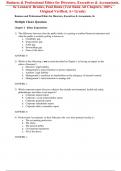Business & Professional Ethics for Directors, Executives & Accountants,
8e Leonard Brooks, Paul Dunn (Test Bank All Chapters, 100%
Original Verified, A+ Grade)
Business and Professional Ethics for Directors, Executives & Accountants, 8e
Multiple Choice Questions
Chapter 1 Ethics Expectations
1) The difference between what the public thinks it is getting in audited financial statements and
what the public is actually getting is known as:
a. Credibility gap
b. Expectations gap
c. Audit gap
d. Stewardship gap
e. None of the above
ANSWER: b
2) Which of the following is not a trend described in Chapter 1 as having an impact on the
ethics of business?
a. Directors’ legal liability
b. Management’s stated intention to protect reputation
c. Auditors’ legal liability
d. Management’s assertions to shareholders on the adequacy of internal controls
e. Management’s stated intention to manage risk
ANSWER: c
3) Which corporate report discusses subjects that include environmental, health and safety,
philanthropic and other social impacts?
a. Corporate annual report
b. Corporate social responsibility report
c. Corporate quarterly report
d. Corporate stakeholder report
e. Corporate ethics committee report
ANSWER: b
4) Professional Accountants, in their fiduciary role, owe their primary loyalty to:
a. The accounting profession
b. The client
c. The general public
d. Government regulations
e. All of the above
ANSWER: c
Business and Professional Ethics for Directors, Executives & Accountants, 8e, 1
L.J. Brooks & P. Dunn, Cengage Learning, 2018
,5) Ethical corporate behavior is expected to lead to:
a. Higher profitability in the short-term
b. Higher profitability both in the short-term and long-term
c. Lower profitability in the long-term
d. Higher profitability in the long-term
e. Lower profitability both in the short-term and long-term
ANSWER: d
6) Examining the interests of stakeholders is probably required for:
a. High short-term profits
b. Optimal medium and longer-term profits
c. Continuing support from stakeholder groups
d. Effective risk management
e. All of the above
ANSWER: a
7) A value that is almost universally respected by stakeholder groups is:
a. Super norm
b. Alfa norm
c. Value norm
d. Hypernorm
e. General norm
ANSWER: d
8) Since the mid-1990s, both management and auditors have become increasingly:
a. Profit management oriented
b. Ethics oriented
c. Value management oriented
d. Risk management oriented
e. Marketing oriented
ANSWER: d or b
9) The following are determinants of reputation:
a. Trustworthiness and Responsibility
b. Credibility, Responsibility and Relevance
c. Responsibility and Impartiality
d. Relevance and Impartiality
e. Relevance, Credibility and Responsibility
ANSWER: a
Business and Professional Ethics for Directors, Executives & Accountants, 8e, 2
L.J. Brooks & P. Dunn, Cengage Learning, 2018
,10) The following would be a key control function of the Board of Directors:
a. Set guidance and boundaries
b. Appoint CEO
c. Approve the sale of company’s assets
d. Decide on the company’s auditor
e. All of the above
ANSWER: e
11) Companies attempt to manage the risk of something happening that will have a negative or
positive impact on the company’s objectives, such as:
a. Credit risks
b. Litigation risk
c. Reputation risk
d. Ethics risks
e. All of the above
ANSWER: e
12) Most large corporations do not consider these risks in a broad and comprehensive way:
a. Operational risks
b. Reputational risks
c. Credit risks
d. Market risks
e. Ethics risks
ANSWER: e
13) The following are examples of ethics risks faced by employees:
a. Honesty and integrity
b. Fairness and compassion
c. Integrity and responsibility
d. Fairness and integrity
e. Responsibility and honesty
ANSWER: b
14) Not reporting environmental issues is an example of:
a. Lack of transparency
b. Lack of integrity
c. Lack of accuracy
d. All of the above
e. None of the above
ANSWER: b
Business and Professional Ethics for Directors, Executives & Accountants, 8e, 3
L.J. Brooks & P. Dunn, Cengage Learning, 2018
, 15) Incomplete disclosure of the company’s revenue recognition policy is an example of:
a. Lack of transparency
b. Lack of integrity
c. Lack of accuracy
d. All of the above
e. None of the above
ANSWER: a
16) This philosophical approach requires that an ethical decision depends upon the duty, rights,
and justice involved:
a. Consequentialism
b. Virtue ethics
c. Duty ethics
d. Righteousness
e. Deontology
ANSWER: e
17) The Modified Moral Standards Approach focuses on the following dimensions of the impact
of a proposed action:
a. Net benefit to society, fair to all stakeholders, whether it is right, virtues expected
b. Net benefit to society and whether it is legal
c. Net benefit to society, fair to all stakeholders, whether it is legal
d. Fair to most stakeholders and whether it is right
e. Net benefit to society, fair to most stakeholders, whether it is right
ANSWER: a
18) This organization is developing an international code of conduct for professional accountant:
a. International Accounting Standards Board
b. European Federation of Accountants
c. Financial Accounting Standards Board
d. Public Accounting Oversight Board
e. International Federation of Accountants
ANSWER: e
19) The following is a fundamental factor in having an effective ethical corporate culture:
a. Tone at the top (Ethical leadership)
b. Efficient oversight by the company’s Board of Directors
c. Workplace ethics
d. Code of conduct
e. Ethics risk management programs
ANSWER: a or c
Business and Professional Ethics for Directors, Executives & Accountants, 8e, 4
L.J. Brooks & P. Dunn, Cengage Learning, 2018




